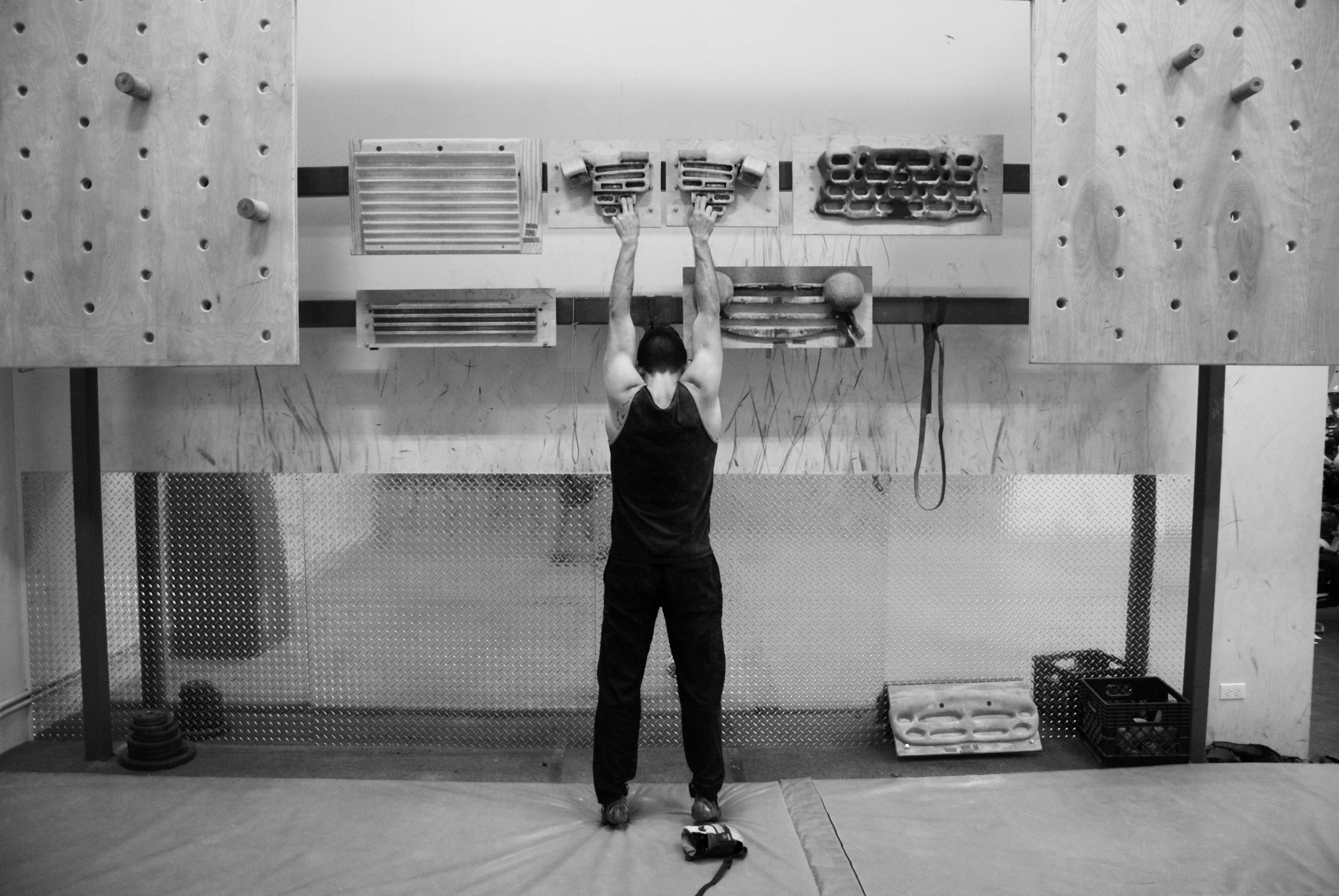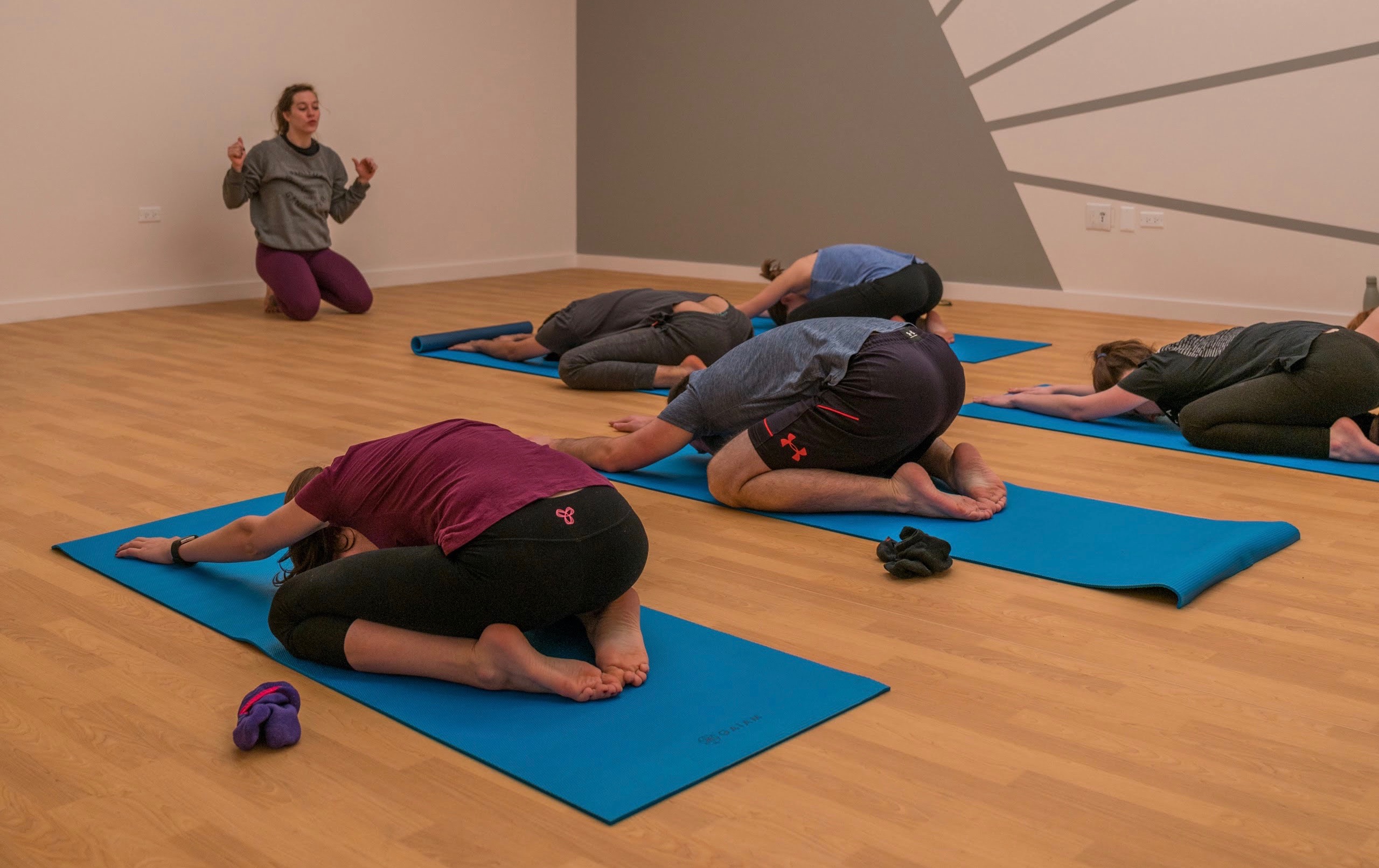After climbing in the gym for a while, you’ll inevitably get bit by the outdoor bug. Maybe you’ve been venturing up to Baraboo for some quartzite bouldering, or your friends have shown you the glory of the Red River Gorge in October. In any case, everyone at some point realizes how much harder and more technical real stone is than polyurethane holds. Many climbers at this point decide to begin to train, rather than simply climb casually whenever they hit the gym. It’s how to break through plateaus, after all – but with this switch in approach comes the potential for injury.
Climbing has traditionally not had a ramping up period during which new climbers learn how to train, the way more popular team sport athletes do. Commonly, climbers feel they want to get “stronger,’ so they begin to attack the hangboard or bouldering wall without the long-term strategy needed to prevent the most common climbing issues: overuse injuries, which are found in up to 44% of regular indoor rock climbers, according to a 2001 British study.

Overuse injuries, according to the Mayo Clinic, are caused by repetitive trauma due to either overtraining (e.g. working that V5 repeatedly, all session) or bad technique, which overloads specific muscles with forces they’re not equipped to handle. Think about power outages: when an electrical system is working, the wattage spreads out over the entire system, not overburdening any one node in the system. But when one node fails, its burden overloads the next, which overloads the next, and so on, until no one link in that chain can contain the force, resulting in the system shutting down.
In climbers, that “power outage” results in overuse injuries, specifically in the hands, elbows, and shoulders. In the case of tendon injuries, such as tennis elbow or an A2 pulley strain, the recovery time is much greater compared to muscle strains, because these components of the musculoskeletal system receive less blood flow than muscles do. You probably know someone who’s experienced at least one of these:
- Pulley strains: the most common climbing injury, often the result of overdoing a closed hand crimp after not letting your hands recover from frequent climbing. Tendons and pulleys don’t strengthen the way muscles do; climbers can quickly become strong enough to inflict damage on their own hands when performing closed crimps without proper technique and recovery.
- Tennis elbow: this is a form of tendinitis, or inflammation, caused by overusing your forearm extensor muscles, which must fire to stabilize your forearm while gripping the holds using your flexor muscles. While climbing, the tendons connecting your extensors to the elbow can develop small tears and inflammation, leading to irritation that can make continued climbing difficult, and even impossible, without rest and treatment
- Shoulder impingement: This is an injury to a shoulder muscle, the supraspinatus, which stabilizes the shoulder joint. When it’s subjected to forces like swinging or too much repetitive trauma from hard climbing, it weakens and destabilizes the shoulder joint, pinching the tendon while the arm passes through a specific range of motion. This condition represents about 80% of shoulder injuries in climbing.
The frustrating truth about overuse injuries is that in mild cases, they can slip under the radar, until they flare up and become lasting issues, requiring professional treatment in order to recover, especially with severe pulley strains and shoulder impingements. The best way to stay out of that 44%, then, is to prevent these conditions in the first place.
In any sport, preventing injury is a long game: athletes need to think ahead about the stresses the body will face throughout a season or training plan, and plan accordingly – including sleep, diet, and mental health. These will differ based on your goals and your body. However, every climber can incorporate routine practices into their training sessions that, despite being a bit boring at times, will build a musculoskeletal foundation that can help to buffer against injury, and give you a springboard to recovery if you are struggling with these issues (with the help of a physical therapist or sports doctor).
Here are 5 basic practices climbers can incorporate into their routines:
1. Warm Up
The single most common cause of most overuse injuries is simply ramping up strenuous climbing too much too soon. While this applies over multiple sessions as well as over any individual session, starting each session with regular and proactive warmups will crank up your heart rate, pumping more blood to your climbing muscles and tendons.The most highly effective and dual-purpose method of warming up is to practice dynamic stretches, which boost blood flow while also activating and lightly stretching muscles you’ll use during your workout. Try starting your sessions with the following:
1. Light cycling will begin to raise your heart rate slowly and get the blood flowing. Do this for 5-7 minutes.
2. Walking lunges activate your hips and force you to use your core, both contributing to better climbing once you’ve warmed up. Do two sets of ten on each leg, and take it slow and controlled to lessen stress on your knees.

3. Windmills will stretch your shoulder joint while beginning to send blood through the joint and into your arms. Do two sets of ten on each arm. These should be done quite slowly and with control.

2. Practice Form Intentionally
Once you’ve gotten your blood flowing, don’t jump right into climbing hard. Now’s the time to get your session going the right way – with easy climbing focused on proper form. Because so many injuries are caused by improperly loading different muscles and tendons due to bad technique, this phase is critical – it builds muscle memory that will kick in when you’re pumped and stressed on a challenging project. For example, notice how in the below photo, the climber has a loose core, which directs the dangling weight of his body off his hands alone. Over time, this kind of climbing will cause problems potentially in the shoulders and hands as he begins to try harder and harder to send problems.

Now, notice how he’s brought his hips into alignment using his core: this allows him to transfer some forces off his hands and support his body using more of his legs, while also controlling dynamic forces that his arms would need to compensate for, at some risk of injury.
3. Do More Than Just Climb
Climbing will use muscles in very specific directions and planes of motion. Repetitive use of these motions can create muscle imbalances, which magnify wear and tear on your tendons. In most of your training plans, make sure to include other activities that use different muscle groups than pure climbing or hangboarding.  Yoga’s a great start – FA offers classes every day. Trail running is another great example – it offers lateral motion moving side to side and up and down over obstacles, and tends to go at a slower, less stressful pace than road running. These lateral motions build “side to side” strength and stability, which will support “up and down” climbing strength to help prevent injury. The critical point is to choose activities that offer complementary, not identical, motions to rock climbing, and to build that into your weekly routines.
Yoga’s a great start – FA offers classes every day. Trail running is another great example – it offers lateral motion moving side to side and up and down over obstacles, and tends to go at a slower, less stressful pace than road running. These lateral motions build “side to side” strength and stability, which will support “up and down” climbing strength to help prevent injury. The critical point is to choose activities that offer complementary, not identical, motions to rock climbing, and to build that into your weekly routines.
4. Rest
Training is only part of the equation in injury prevention. It’s fairly common in climbing to show some pride around how many days “on” you’ve climbed, but this reflects some misunderstanding of how strength is built (although it can be hard to take a day off when you’re on a trip!). Days “on” are destructive on the body, particularly on your tendons – which can’t be trained rapidly the way muscles can be. Days off are when the strength and tendon resilience builds throughout your whole body after training. Rest is at least as important as gym time – take it slow, and don’t push through abnormal pain.
5. Get Expert Input
Once you’ve gotten those preventative habits down (or even if you need help with them), it’s now time to get onto a training plan. You may be tempted to start hangboarding with friends or download a pre-made training plan online, but having the right training plan for you is an essential part of preventi ng injury and ultimately achieving your goals. You can find great resources to craft your own training plan – online resources from Climbing Magazine to TrainingBeta’s podcast, or a well-known climbing training book like How To Climb 5.12 by Eric Horst or The Rock Climber’s Training Manual by Michael & Mark Anderson. But the best option is always to work with a professional trainer locally. We encourage you to check out First Ascent’s 90-minute Redpoint Assessment, where a Redpoint coach will assess your climbing ability over a wide range of metrics and provide you with a personalized training plan that not only makes you a stronger and more skilled climber, but also a healthier one for the long term. Check the Redpoint Training page on our website or email redpoint@firstascentclimbing.com for more information.
ng injury and ultimately achieving your goals. You can find great resources to craft your own training plan – online resources from Climbing Magazine to TrainingBeta’s podcast, or a well-known climbing training book like How To Climb 5.12 by Eric Horst or The Rock Climber’s Training Manual by Michael & Mark Anderson. But the best option is always to work with a professional trainer locally. We encourage you to check out First Ascent’s 90-minute Redpoint Assessment, where a Redpoint coach will assess your climbing ability over a wide range of metrics and provide you with a personalized training plan that not only makes you a stronger and more skilled climber, but also a healthier one for the long term. Check the Redpoint Training page on our website or email redpoint@firstascentclimbing.com for more information.
By Chris Rooney, an FA member and freelance writer specializing in rock climbing, fitness, and the outdoors.
Sources
theclimbingdoctor.com
drjuliansaunders.com/shoulder-impingement
